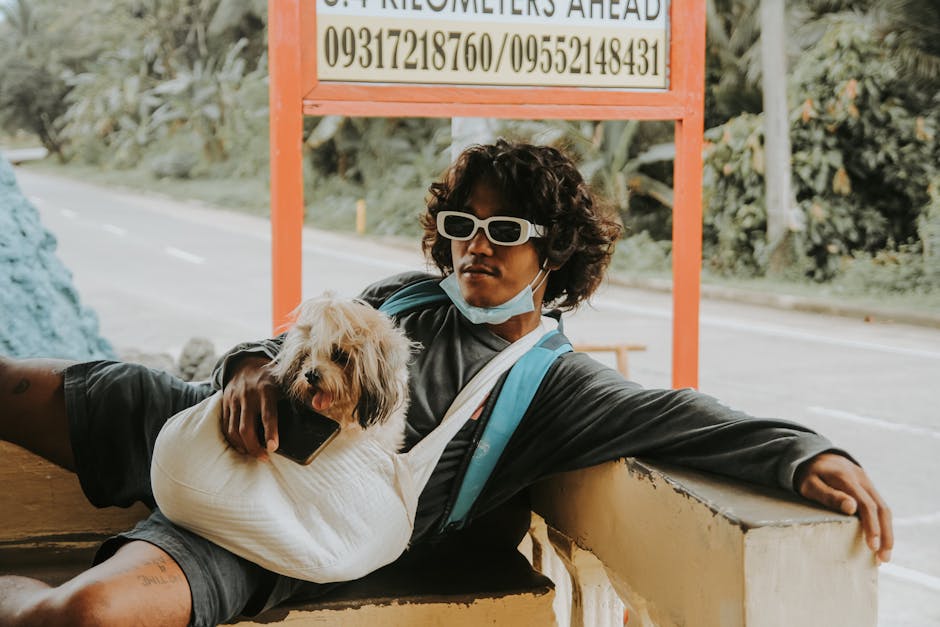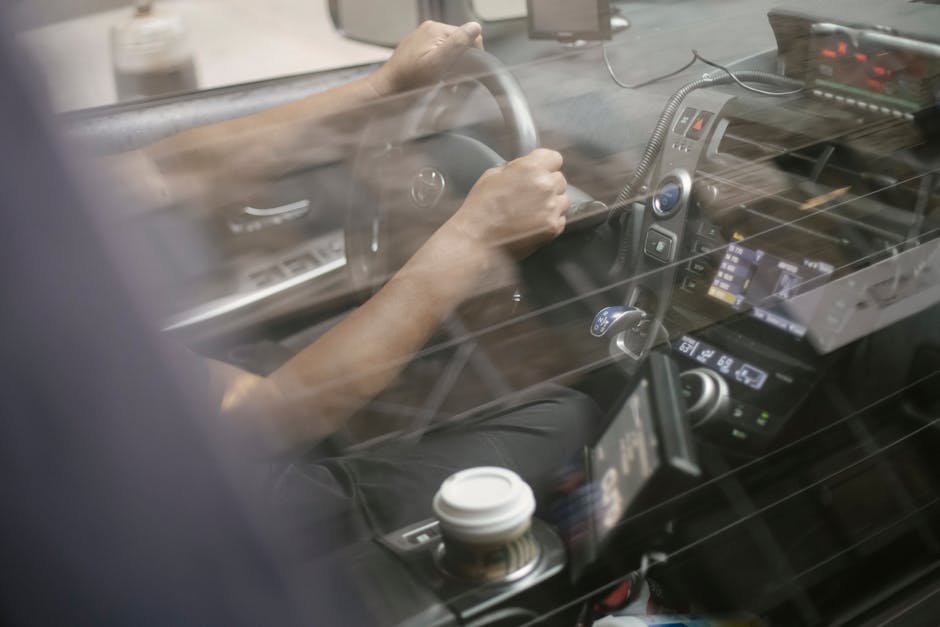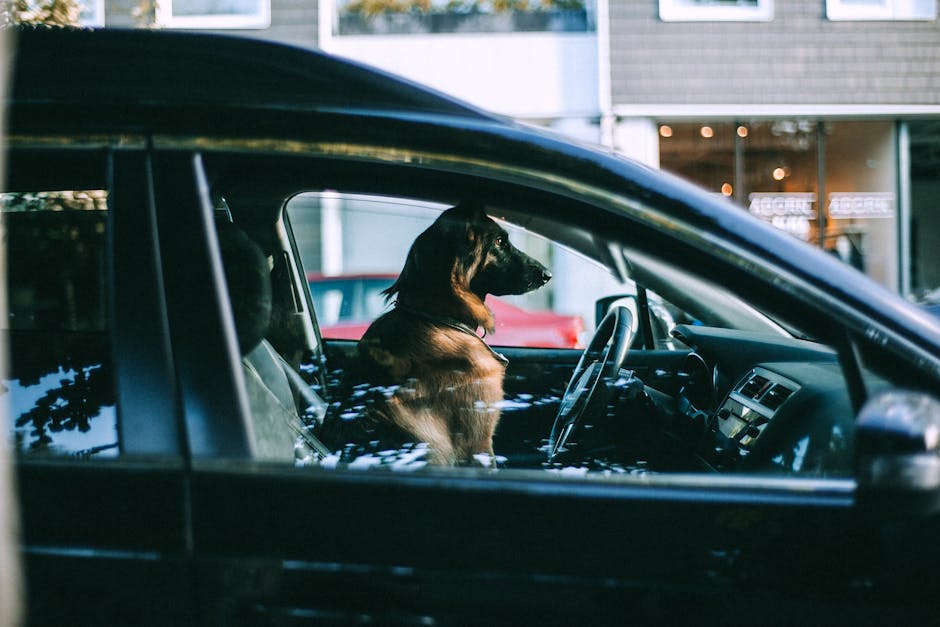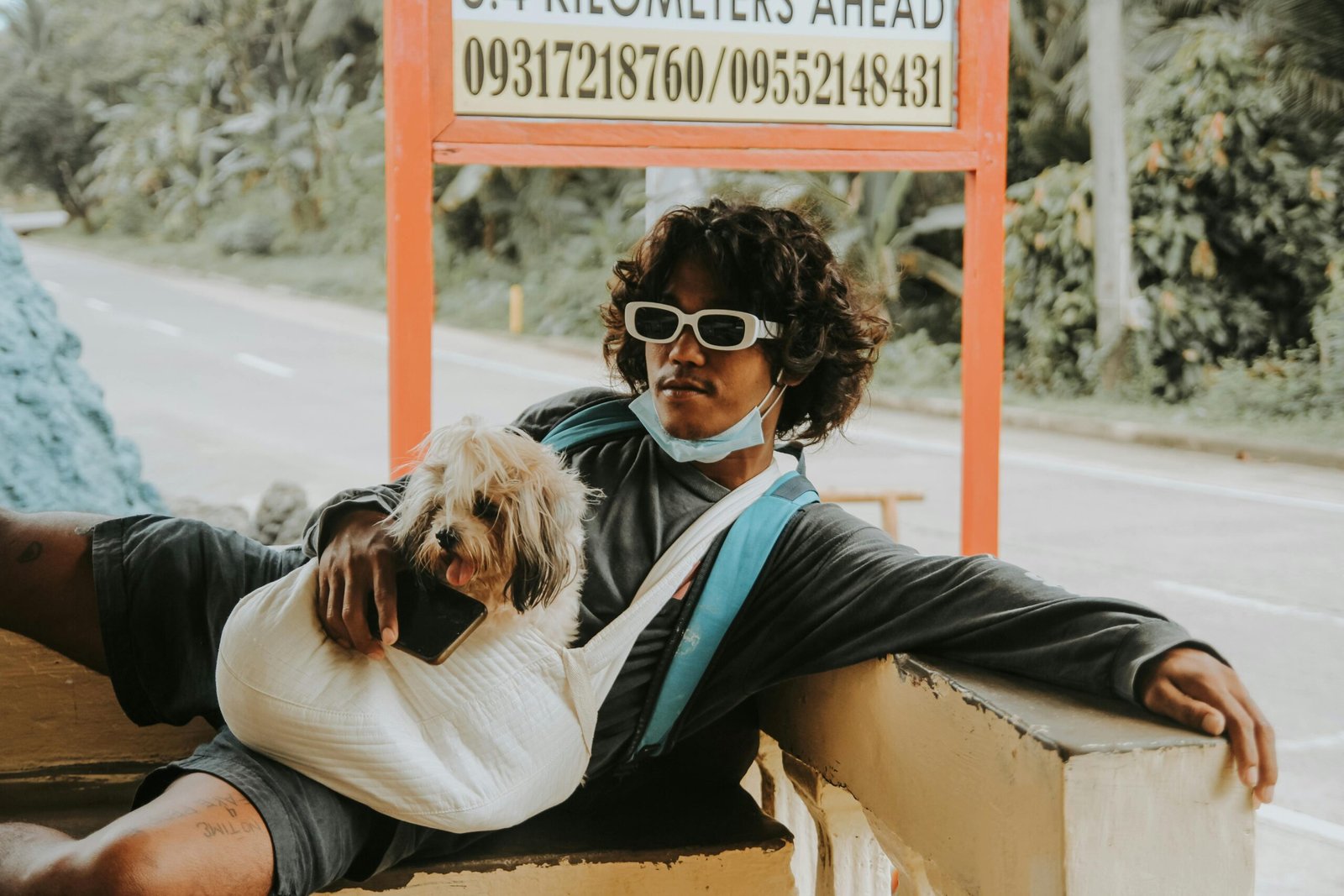Introduction
Traveling with pets: it’s an adventure that’s often punctuated by equal measures of pandemonium and amusement. Furry companions introduce an entirely new variable to the equation of travel. They transform routine road trips into safaris and transform everyday campouts into quests. They add an undeniable ray of delightful chaos to journeys, making them unforgettable. But let’s be honest, they also introduce challenges that can turn an otherwise enchanting trip into a stress-filled ordeal.
Indeed, as any pet parent will testify, voyages with our four-legged pals can often resemble a roller-coaster ride, filled with ups and downs. One moment, we’re in stitches over Fido’s hilarious reaction to seagulls at the beach. The next, we’re frantically surfing the Web for the nearest vet clinic because the same silly dog decided to snack on something strange. It’s a journey matched only by the love we have for these lovable creatures.
But fear not! With the right tips and guidance, traveling with pets can be as smooth as a fun frolic at the dog park. So what’s next? This article aims to be your trusty guide, packed with helpful advice for navigating the enchanting labyrinth of traveling with pets.

The Basics of Traveling with Pets
Venturing into the vast outdoors with your furry friend can be an exhilarating adventure, a momentous journey stamped with paw prints. If you’re game for this experience, let’s start by digging into the bare necessities.
First and foremost, you need to ensure your pet is travel-ready. This correlates to the importance of good health and up-to-date vaccinations for your pet before you embark on your journey. Animals, like humans, have unique needs and can experience motion sickness or stress triggered by new environments or activities – factors which become even more consequential in the case of prolonged travel. If your pet isn’t in tip-top shape, the adventure you had in mind could quickly take a turn for the worse. Health first, travel second.
Second, have a heart-to-heart with your vet. It’s crucial to understand your pet’s specific medical history and needs, and align these with the travel plans you are concocting. Your vet can provide advice on dealing with your pet’s individual challenges and needs during travel, and guide you on the right emergency medication to pack.
Lastly, be aware that each destination has unique pet regulations and potential health risks. It’s essential to research these aspects ahead of your journey to avoid any missteps. A quick search online or a chat with other pet owners who’ve walked—or trotted—this path before, should do the trick.
When you’re in travel mode, there’s no room for guesswork. Understanding these basics isn’t just about ticking off a checklist, but about safeguarding your four-legged friend’s health and ensuring a hitch-free journey.
Remember, adventure calls – but only if your pet is ready to answer with a furry high-five!

Pre-Travel Preparations for Pets
Setting off on an adventure with your furry friend is exciting, to say the least. But, behind every Insta-worthy, trouble-free pet travel experience lies a whole lot of meticulous pre-trip preparations. Before you even start packing, it’s crucial to consider your pet’s overall well-being and safety.
A key starting point is a comprehensive vet check-up. Don’t just assume that your pet is fit for travel. Let your trusty vet make that call. This step is crucial to identify any hidden health problems and to ensure your pet’s vaccinations are up to date. It can be a bummer if you end up with a sick pet in an unfamiliar place, so this initial vet check-up is a non-negotiable stage in your pre-travel planning.
Next on the list is to update ID tags and consider micro-chipping your pet if you haven’t already. Lost pets are a tragedy, but sadly, they are a common fallout of travel escapades gone astray. The easier it is for a well-meaning stranger to identify your pet and reach you, the better the chances of a happy reunion. Therefore, ensure your pet’s ID tags have your current contact information, and if you opt for micro-chipping, remember to register and keep your particulars up to date on the appropriate database.
Finally, the dreaded carrier crate or travel harness. These gadgets can seem alien and uncomfortable to your pet if introduced at the last minute. Therefore, get your pet accustomed to them well before you plan to hit the road. Start by leaving the crate open in your home for your pet to explore. Gradually increase the time they spend in it. By the time you’re ready to set off, your pet should associate the crate or the harness with a safe and secure spot. This simple move goes a long way in reducing stress and anxiety for pets on a journey.
Remember, enjoyable pet travel begins with proactive and thoughtful pre-travel prep. It may seem like a lot, but the peace of mind it offers makes it totally worth it.

Making the Journey Comfortable for Your Pet
Understanding that each furkid has an individual temperament and unique needs is key to making their journey comfortable. One size does not fit all in this case, and thus your pet’s preferences and necessities should guide each decision you make.
First, you want to get the feeding and hydration right. Remember, an overfed or underfed pet can lead to problems. Offer a light meal 3 to 4 hours before departure to balance their hunger and reduce the chance of them getting carsick. Always carry plenty of freshwater, particular in hot weather or long trips, to keep your pet hydrated. Invest in portable pet water bottles or travel bowls to make it easier. However, avoid feeding your pet in a moving vehicle. Their tummies may not take it well.
Next, particularly pertinent for road trippers, making regular stops is essential. Think of these as ‘pet breaks’ – brief respites from the confined car space where your dog can stretch their legs or your cat can get some much-needed privacy in a quiet corner. This break is also a good time for bathroom duties. Make sure to maintain leash control during these stops since unfamiliar environments could spook your pet.
In the vehicle, make sure your pet is safely restrained whether it’s a harness, carrier, or a vehicle pet barrier. If it’s their first time, let them acquaint themselves with this place before the trip. It’s no easy feat to find that perfect spot in the car where they neither obstruct your view nor does the sun hits directly. Safety and comfort are paramount here.
And let’s not leave out the idea of keeping their favorite toy or blanket handy. Familiar smells create a sense of comfort for pets in an unfamiliar moving environment, and could significantly lessen the travel anxiety. Remember, comfort means calm, and a calm pet makes for a serene journey.
In summary, feeding and hydration done right, regular stops, proper restraint, a comfortable spot in the car, and familiarity – all these play vital parts in making the journey comfortable for your beloved pet. Tailoring these aspects to the individual quirks and needs of your pet will ensure that both you and your furry friend have an enjoyable time on the road. Now that’s what we call, happy travels!

Pet-Friendly Travel: Ensuring Comfort and Safety for Your Pets
When you’re traveling with pets, ensuring their comfort and safety is just as important as your own. This means you have to plan in advance to find pet-friendly accommodations both for your journey and at your destination. Given that not all places are open to our furry friends, it’s essential to avoid unexpected surprises by confirming pet policies ahead of time.
Start with a Simple Online Search
There are many websites that offer comprehensive lists of pet-friendly hotels, restaurants, and attractions. Websites such as BringFido, Petswelcome, and the pet-friendly filters on Tripadvisor and Airbnb can serve as great starting points for your research.
Understand the Pet Policies
However, don’t stop at simply identifying pet-friendly locations. It is important that you also learn the specifics of their pet policies. This can include:
- Contacting hotels or restaurants in advance to clarify restrictions on the size or breed of pets
- Understanding any possible additional fees
- Knowing specific rules that you must adhere to during your stay
Remember, the goal is to ensure your pet feels just as welcome as you do. Always be considerate of other guests and follow all rules set by your accommodation.
Plan for Pet-Friendly Pit Stops
Also focus on finding pet-friendly pit stops for your journey. Regular breaks are crucial for pets to stretch, hydrate, and take care of their needs. Websites like GoPetFriendly can be handy for locating ideal rest areas, parks, and attractions where you can take a break with your pet while on the road.
Conclusion
Traveling with pets requires conscientious planning, but the reward of sharing your adventures with your four-legged friend makes it all worthwhile. Remember, a happy pet makes for a happy trip, so always prioritize their comfort and happiness when making travel plans.

Pet Care on The Road
As any pet owner knows, maintaining good hygiene is key for a healthy pet, and this remains equally important when on the road. It’s not just about keeping your vehicle clean from fur or the occasional accident, but also about ensuring that your pet feels fresh and comfortable throughout the journey. Pack essentials such as pet-friendly wipes for on-the-go clean-ups, a travel-sized grooming kit, and some towels. If your trip extends over a few days, consider packing a portable pet bath or identifying pet grooming facilities along your route.
One significant part of road travel with pets that could be challenging is dealing with potential health issues or anxieties. Pets can often suffer from motion sickness, and unusual environments can make them anxious. To counteract these issues, ensure your pet is secured in a well-ventilated crate or harness for comfort and safety. Car shades can be beneficial to prevent overheating. For anxious pets, try products like calming collars or anxiety wraps. You could also consider taking a few shorter rides before the big trip to help acclimate your pet to the travel experience, thereby reducing anxiety. Despite precautions, if your pet seems excessively uncomfortable, consult a vet before continuing with your journey.
Lastly, while trip schedules often get erratic, endeavor to maintain your pet’s regular feeding and walking schedules as much as possible. Stick to your pet’s regular diet to prevent digestive issues. Avoid feeding your pet in a moving vehicle as it could trigger motion sickness. Make sure to carry plenty of water for your pet and offer it frequently, especially if you’re traveling in warm weather. Remember to make plenty of rest stops – not only for bathroom breaks but also to let your pet stretch their legs and get some exercise. A tired pet is a content pet, and the chances are that they’ll welcome the return to the vehicle for a good nap!
Maintaining your pet’s care on the road might seem a bit daunting initially, but with proper planning and understanding your pet’s needs, you can ensure a pleasant experience for both of you.

What to Pack for Your Pet
Packing for pets involves more than just packing dog bowls and a leash. Being prepared for any eventuality is important for a smooth journey. Here’s a comprehensive checklist.
Important Documents
- Essential Paperwork: Carry a copy of your pet’s latest vaccination records and an updated health certificate if you’re crossing state or international borders. Include a copy of your pet’s ID and a recent photograph for unforeseen circumstances.
Tools for Control and Identification
- Collar, Leash, and ID Tags: A leash helps maintain control in the bustling travel environment, while an ID tag assists in safe return if your pet gets lost.
Food and Hydration
-
Food and Water: Pack enough food for your journey plus a few extra days for any delays. Always have ample fresh water available.
-
Portable Bowls: Collapsible food and water dishes are space-efficient for feeding on the move.
Health and Safety
- First-Aid Kit: Carry a pet-friendly first-aid kit. Essential items should include tweezers for tick removal, bandages, and any specific medication your pet may need.
Comfort and Entertainment
-
Toys and Treats: Favorite toys can keep your pet entertained. Treats can provide distraction during stressful travel moments.
-
Comfort Items: Include your pet’s bed or blanket and an article of clothing that smells like you for comfort in unfamiliar environments.
Sanitation and Maintenance
- Clean-up Supplies: Pack portable waste bags for dogs, and litter boxes for cats. Wipes and towels may come in handy for unexpected accidents.
Transportation and Safety
- Containment System: Depending on your mode of travel, crates or harnesses are important. They not only fulfill many travel companies’ requirements but also keep your pet safe during the journey.
While this may seem like an exhaustive list, packing these items will give you peace of mind and ensure a smooth trip for both you and your four-legged companion. Bon voyage!

Returning Home from Travel with Pets
After the fun-filled travel adventure or perhaps a necessary trip is over, it’s finally time to head back home with your pet. This return journey is just as important as the outward one, and there are certain things to consider.
First off, be aware that transitioning back into their regular routine may take time for your pet. They’ve been navigating unfamiliar environments, and this can be exhausting. When you reach home, give them some time to rest and reorient.
Be attentive and watch for signs of stress or changes in behavior. It’s not uncommon for pets to experience a lag in energy or appetite after coming back from a trip. But if the symptoms persist, there could be a more substantial underlying issue such as travel-related stress or possibly a disease caught from another animal on the road.
Continuing with monitoring, make sure you’re keeping an eye out for ticks, fleas, and other parasites your pet might have picked up during the trip. Thoroughly check their skin and coat. If you are uncertain, a vet check-up post-travel isn’t a bad idea.
While unpacking your stuff, remember to clean and put away pet travel gear. Sanitize the crates, carriers or car seat covers. This will help remove any dirt or bacteria, and it’s all set for the next journey.
Finally, returning to the normal feeding and exercise schedule is essential. However, try to do this gradually. Too abrupt a shift back to ‘normal’ life can cause unnecessary stress to your pet. Treat them with their favorite meal perhaps, cuddle them more than usual, or add a little more playtime than the usual.
Remember, your pet’s health, comfort, and happiness are just as important after the journey as during, ensuring this will support a more seamless transition back to regular life and be ready for the next travel adventure together.

Common Mistakes Pet Owners Make When Traveling With Pets
Traveling with pets can easily become a humorous anecdote machine – think “Fido mistook the luggage for a bathroom” – yet it’s not all fun and games. Let’s mull over some common goof-ups pet owners make, so we can steer clear of them.
Neglecting to research pet policies: Many pet owners pack up Fido or Whiskers and hit the open road or friendly skies without giving much thought to the pet policies of airlines, hotels, and stops along the way. It’s a rookie mistake that can lead to a ton of unnecessary stress and additional costs. Do your homework in advance: research pet-friendly spots and clarify policies before you start your journey to avoid unpleasant surprises.
Skipping the vet visit: “Fido seems healthy. Why bother dragging him to the vet?” The answer is, you never know what could happen on the road. A health check-up and up-to-date vaccinations can save a pet’s life, especially when traveling where different types of flora, fauna, and pests exist.
Assuming that pets will adjust: This can be a biggie. Pets are creatures of habit. Even minor shifts in their routine can cause anxieties or behavioral issues, let alone packing them off to a completely new environment. Acclimatize them gradually to new elements of travel like car rides, crates, or leashes to make the journey less stressful.
Overlooking hydration: This one is often underestimated. While on the road, especially during hot weather, pets need extra hydration. Not packing enough water and taking regular water breaks can risk dehydration in pets.
Ignoring your pet’s personality: Not every pet is a fan of adventures. Some might simply prefer the couch’s comfort. If you’re forcing a reluctant or anxious pet into travel because you think they should enjoy it, think again.
Finally, forgetting an emergency plan: Amid the excitement of travel, many pet owners tend not to plan for emergencies. It’s crucial to have a contingency plan in case of medical emergencies or if the pet accidentally strays.
Nobody wants to be “that” pet parent, right? Understanding these common errors and planning accordingly will go a long way in ensuring a memorable and pleasurable travel experience with your pet pals.

Conclusion
Our journey exploring the how-tos of traveling with pets comes to an end here. Let’s review the main touch points we journeyed through. Just like planning an adventure with a small human, traveling with your pet can be immensely joyful, but requires careful planning and preparation.
Health and Preparation
We commenced our expedition with attention on the basics. The primary focus here was:
- Ensuring pets are in good health and are up-to-date with necessary vaccinations.
- The critical importance of pre-travel preparations like vet check-ups, ID tags, and acclimating your pet with travel gear.
On the road
The cardinal factors that need extra attention while on the road include:
- Prioritizing comfort with attention to pet-specific needs.
- Taking care of suitable feeding, hydration requirements and regular rest breaks.
- Identifying and planning for pet-friendly stays and pit stops.
Pet Care On the Trip
Points of emphasis while discussing pet care during the trip were:
- Ensuring hygiene and keeping a watchful eye for possible health warnings or signs of travel anxieties.
- Upkeep of routinely feeding and walking schedules, as far as possible.
Checklist and Post Travel Care
Our fruitful discussion extended into:
- A handy checklist of all essential items for your pet.
- Ensuring post-travel comfort by helping your pet ease back into their home routine.
- Spotting signs of post-travel stress or discomfort.
- Avoiding common traveling blunders pet-parents often make.
With meticulous planning and vigilant care, traveling with your pet can transform from a stressful challenge into an enriching experience. Don’t shy away from adventures with your furry friend. With the right preparation, a secure and enjoyable trip, in the great company of your pet, is very much possible. Cheers to safe travels, pet parents!
